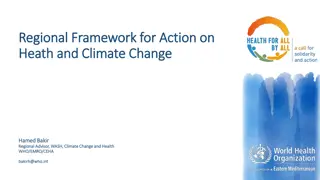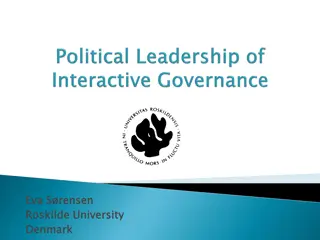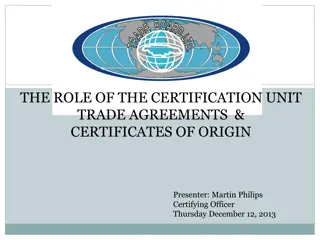Understanding International Climate Agreements and Governance
Delve into the intricacies of global climate governance with a focus on the Paris Agreement, UNFCCC history, key commitments, and the Kyoto Protocol. Explore the evolution of international fora and the concerted efforts to address climate change through mitigation, adaptation, and cooperation.
Download Presentation

Please find below an Image/Link to download the presentation.
The content on the website is provided AS IS for your information and personal use only. It may not be sold, licensed, or shared on other websites without obtaining consent from the author. Download presentation by click this link. If you encounter any issues during the download, it is possible that the publisher has removed the file from their server.
E N D
Presentation Transcript
Paris Agreement and Rulebook
Overview International climate governance Paris Agreement and Rulebook in detail - Mitigation & adaptation - Means of implementation and support - Reporting & compliance framework Implications for domestic law and policy
International fora UN GA & SC International Maritime Organization (IMO) and International Civil Aviation Organization (ICAO) Protection of the Ozone layer (Montreal Protocol), Trans-boundary Air Pollution Law of the Sea, Biodiversity, UNESCO, FAO, WTO UNFCCC
UNFCCC history 1988 IPCC established 1992 UNFCCC adopted (entry into force 1994) 1998 Kyoto Protocol adopted (entry into force 2005) Shift towards global responsibility for GHG emissions, adaptation and loss and damage 2009 Copenhagen Accord 2011 ADP (Durban Platform for enhanced Action) 2012 Doha amendments to the Kyoto Protocol 2015 Paris Agreement (2016), APA 2018 Paris Agreement Rulebook
UNFCCC Key commitments (based on the CBDR and RC) All Parties: Publish national inventories of greenhouse gas emissions Developed Country Parties: Adopt national mitigation policies Provide new and additional financial resources for developing countries Assist developing country Parties particularly vulnerable to climate change in meeting the costs of adaptation Take all practicable steps to promote, facilitate and finance the transfer of technology Take full account of the specific needs and special situations of the LDCs Ultimate Objective: To stabilise greenhouse gas concentrations in the atmosphere at a level that would prevent dangerous anthropogenic interference with the climate system. Guiding Principles: Equity Common but differentiated responsibilities and respective capabilities (CBDR-RC) Specific needs and special circumstances of developing country Parties Precautionary Principle Sustainable Development Principle of Cooperation
Kyoto Protocol Article 2 - Mitigation policies and measures Article 3 Legally binding targets for emissions of six GHG and timetable Articles 6, 12 and 17 New market-based mechanisms creating a new commodity: carbon Articles 5, 7, 8,18 - Reporting and compliance Article 11 - Financing for developing countries
Paris Agreement Adopted in 2015 Entry into force: 2016 International (formally binding) treaty building on Copenhagen Accord Framework agreement PA work program to develop rules for implementation
Key elements 1.5/2 degree goal Bottom up & voluntary NDCs Covers all elements but mitigation focused Dynamic process for reviewing and increasing ambition of Parties contributions Enhanced Transparency Framework Global Stocktake Facilitating compliance mage result for tour eiffel
PA vs. UNFCCC Equity and CBDRRC: capacity and national circumstances > historic responsibility Upfront finance as a result of historic responsibilities (-) Specific needs, special circumstances and vulnerability of developing country parties: all parties (mitigation/adaptation) but within vulnerability (+) Precautionary principle: Art.2 (+), adaptation (+) Sustainable Development: no bunker fuels, intellectual property rights (-) Principle of Cooperation e.g. address gaps in law (?)
COP24 Katowice I Rulebook , work program , implementation rules NDC guidance and accounting not common time frames Program and functioning of Forum on the Impact of the Implementation of Response Measures Not Art.6 cooperative approaches/markets
COP24 Katowice II Adaptation communication, increased visibility of adaptation efforts (recognition?) Loss and damage Monitoring of finance flows, adaptation fund & discussions on new finance goal start 2020 Technology framework (Art.10.4) Not capacity building
COP24 Katowice III Common set of rules with flexibility to report under the enhanced transparency framework Input and outcomes of the Global stocktake (Art.14) Modalities and procedures for involvement of the Committee to facilitate implementation and promote compliance
IPCC special report on 1.5 degrees World temperature has already risen by over 1C since pre-industrial times due to human activity Current emission reduction pledges under Paris Agreement will not limit global warming to 1.5C On current trends it is likely to pass 1.5C mark between 2030 and 2052 Countries will need to increase ambition significantly before 2030 to limit temperature rise to 1.5C
Paris Agreement Implementation rules, methods, processes National implementation by parties Policy, law, regulations, economic tools, awareness raising, etc.
Section General Provisions Preamble, Article 1 definitions, Art.2 the Agreement s purpose and Art.3 NDCs Main substantive elements and commitments Art.4 mitigation Art.5 greenhouse gas sinks and reservoirs and REDD+ Art.6 cooperative approaches Art.7 adaptation Art.8 loss and damage Art.9 finance Art.10 technology development and transfer Art.11 capacity building Art.12 climate change awareness and education Reporting, review and compliance Art.13 transparency, Art.14 global stocktake and Art.15 facilitating implementation and compliance Institutional arrangements Art.16 CMA, Art.17 secretariat, Art.18 SBI and SBSTA, Art.19 other bodies and institutional arrangements to serve the Agreement Art.20 signature and ratification, Art.21 entry into force, Art.22 amendments, Art.23 annexes, Art.24 dispute settlement, Art.25 voting, Art.26 depository, Art.27 reservations, Art.28 withdrawal and Art.29 languages Final articles
General part Preamble: sustainable development, food production, quality jobs, human rights, Mother Earth, climate justice , public participation etc. Global goals: to keep global temperatures to well below 2 C above pre-industrial levels and pursue efforts to limit the temperature increase to 1.5 C (Art.2) Guiding principles: equity and CBDRRC in the light of different national circumstances (Art.2) Nationally determined contributions (NDCs) in general (Art.3) = main vehicle for climate action
Mitigation (Art.4) Parties shall submit increasingly ambitious NDCs every 5 years and pursue domestic mitigation measures, with the aim of achieving the objectives of such contributions (Art.4.2). Developed countries should continue taking the lead through economy-wide absolute emission reduction targets (Art.4.4) Support for developing country Parties (Art.4.5) but not a precondition of action
Mitigation (Art.4) Parties may act jointly (Art.4.16) All Parties are encouraged to formulate long term low GHG emission development strategies (Art.4.19) Parties shall provide national inventory reports and information to track progress (Art.13.7)
Mitigation (Arts.5 & 6) Gas sinks/reservoirs and REDD+ (Art.5) Conserve and enhance emission sinks and reservoirs Reduce emissions from deforestation and forest degradation in developing countries through existing REDD+ framework Voluntary cooperation (Art.6) Cooperative approaches to transfer mitigation outcomes Mechanism to mitigate GHG emissions and support sustainable development (CDM+) Framework for non-market approaches to sustainable development
COP24 - Rulebook further guidance on the features of NDCs; (-) information to facilitate clarity, transparency and understanding (ICTU) of NDCs; accounting for NDCs; modalities and procedures for the operation and use of a public registry for NDCs; common time frames for NDCs; (-) the modalities, work programme and functions of the forum on the impact of the implementation of response measures; matters relating to Art.6 of the Paris Agreement (-)
Art.6 pending issues Transfer of ITMOs in respect of sectors and greenhouse gasses that are not covered by its NDC Use of ITMOs can be used for other purposes than towards an NDC or the required Scope and form of the corresponding adjustments to its NDC Transition of projects and credits from the Kyoto Protocol to the new system Eligible activities (e.g. action on forests) Allocation of tasks (e.g. accrediting entities or approving the issuance of credits) between the supervisory body and host parties Percentage and form of proceeds for adaptation and whether such a levy should be extended to transactions under Art.6 para.2 Including human rights considerations in the reading of sustainable development under Art.6, para.4 (a) Deliver an overall mitigation in global emissions in para.4 (d) = cancellation of some credits (because offsetting does not lead to further overall mitigation)?
National commitments 2nd round of NDCs - based on IPCC guidance ICTU: All categories of anthropogenic emissions or removals in their NDCs (energy, gas, transport) Mitigation co-benefits of adaption action and/or other economic diversification plans (agriculture, waste management) Accounting: source/sink/activity continuously included in future NDCs Natural disturbances on managed land, harvesting of wood products or the age-class structure in forests
Law and policy implications? Regulations in emission areas and data collection Long-term low emission strategy Forest protection, water management (carbon sinks) Markets and carbon trading mechanisms, carbon levies or trade measures GHG inventory biennial reporting (Art.13.7)
Carbon markets Experience in industrialized countries Adjust existing models to the national circumstances To link to Art.6 markets reflect: integrity, transparency, permanence, robust accounting rules etc. E.g. set a regulatory ceiling on greenhouse gas emissions (in line with the NDC) and issue just enough permits within the sectors covered to meet the target Build wider enabling environment (collect and monitor data and incentivize investment) Secure business environment, clear regulatory frameworks, good governance, access to justice etc.
Adaptation (Art.7) Global goal to enhance adaptive capacity, strengthen resilience and reduce vulnerability (7.1) Adaptation efforts of developing countries to be recognized (Art.7.3) Mitigation reduces adaptation efforts (7.4) Adaptation action to be gender responsive, participatory and transparent (Art.7.5) Shall, as appropriate, engage in adaptation planning processes and the implementation of actions (7.9) Should, as appropriate, submit and periodically update an adaptation communication on needs, plans and actions (7.10) as part of e.g. NAPs, NDCs or national communications (7.11) Adaptation communications will be housed in a public registry (7.12)
COP24 Modalities for the adaptation communications public registry: 2 parts Recognizing adaption efforts by developing countries (Art.7.3) with modalities to be developed by Adaptation Committee and LDC Expert Group for adoption at CMA 1 (1/CP.21 para.41) = Operational arrangements enhancing collaboration and profile of adaptation? Further guidance in relation to the (voluntary) adaptation communication, including, as a (possible) component of NDCs
Adaptation Communication National circumstances Institutional arrangements Impacts, risk and vulnerabilities National adaptation priorities, strategies, policies, plans etc. and their implementation, monitoring and evaluation Implementation and support needs Gender responsiveness and use of traditional knowledge
Law and policy implications? System to document and report climate impacts and adaptation action Planning, emergency preparedness, disaster risk reduction etc. Adaptation action should follow a gender responsive, participatory and fully transparent approach taking into account vulnerable groups, communities and ecosystems (Art.7.5) Define needs and plans including financial implications (Art.7.10-12, 13.8)
Global temperature change (relative to pre-industrial) 0 C 1 C 2 C 3 C 4 C 5 C Food Falling crop yields in many areas, particularly developing regions Falling yields in many developed regions Possible rising yields in some high latitude regions Water Significant decreases in water availability in many areas, including Mediterranean and Southern Africa Small mountain glaciers disappear water supplies threatened in several areas Sea level rise threatens major cities Ecosystems Rising number of species face extinction Extensive Damage to Coral Reefs Extreme Weather Events Rising intensity of storms, forest fires, droughts, flooding and heat waves Risk of Abrupt and Major Irreversible Changes Increasing risk of dangerous feedbacks and abrupt, large-scale shifts in the climate system
Loss & damage (Art.8) Further steps to be taken to address loss and damage due to climate impacts (Art.8) Warsaw International Mechanism on loss and damage Disaster response, risk assessment and management, insurance Task force on displacement related to the adverse impacts of climate change (para.49, Decision 1/CP.21) Agrees that Article 8 does not involve or provide a basis for any liability or compensation (para.51, Decision 1/CP.21) Rulebook: Reference to L&D in Transparency and Global Stocktake guidelines
Compensation & liability? Future work of WIM under PA? COP decision does not exclude application of general rules of public international law Principle of prevention/no harm: The existence of the general obligation of states to ensure that activities within their jurisdiction and control respect the environment of other states or of areas beyond national control is now part of the corpus of international law relating to the environment. (ICJ, 1996) UNFCCC and PA = lex specialis? International Law Commission s (ILC) Draft Articles on the Responsibility of States for Internationally Wrongful Acts with Commentary, Art.55 Rules of transboundary pollution apply to climate change? ILA draft principles related to climate change
Palau initiative Do states have a legal responsibility to ensure that any activities on their territory that emit greenhouse gases do not harm other states?
Means of implementation and support
Finance (Art.9) Developed countries shall provide financial resources in continuation of existing obligations (Art.9.1) from a wide variety of sources and through a variety of actions (9.3) No burden sharing agreement or other binding arrangements Biennially communicate indicative quantitative and qualitative information (9.5) and further information on the support actually provided and mobilized (9.7) Developed countries intend to continue their collective mobilization goal through 2025 (USD 100 billion/year from 2020); CMA will set a new collective quantified goal before 2025 (1/CP.21 para.53)
COP24 Clarifies information to be provided ex ante (indicative provision and mobilization) and ex post (finance provided) dedicated online portal why new, barriers etc. ex post integrated in Art.13 decision Adaptation Fund Discussions on new collective quantified finance goal to start in 2020
Sources of climate finance National budget allocations Fees and charges International public climate finance (grants, loans or contributions to the GCF or Adaptation Fund as well as dedicated financial resources by multilateral development banks) International private finance (loans with an end- use restriction, green or climate change bonds, market mechanisms envisaged under Art.6 PA)
Domestic law and policy Assessing costs of proposed climate change response actions in the short and medium term and resources available; Potential entry points for relevant finance institutions; Mobilizing climate finance via financial mechanisms such as loans, guarantees and insurance, green investment banks, climate trust funds, clean development mechanisms, carbon facilitative modalities are non-financial initiatives to help indirectly mobilize private finance by enhancing capacity building, knowledge transfer, governance structures, prudential regulation, corporate reporting, etc. National efforts/mechanism to bundle and/or blend different climate finance resources pricing, green bonds etc.
Technology (Art.10) Enabling innovation via collaboration and facilitating access (para.4) Technology framework to guide existing mechanism: Technology Executive Committee (policy) & Climate Technology Centre and Network (implementation) CTCN: Advisory board, national designated entities, UNEP/UNIDO and network of organizations Technology solutions, capacity building and advice on policy, legal and regulatory frameworks to promote transfer Support for developed country parties (Art.10.5 & 6) and report on support received (Art.13.10) Modalities for the periodic assessment of the effectiveness and adequacy of the support provided to the mechanism (2021-22) Key themes: innovation, implementation, capacity building etc.
National implications System to identify and communicate technology needs and priorities (Technical Needs Assessment Process) National coordination and stakeholder consultations Define support needed by developing country parties (Art.10.6) and report on support received (Art.13.10)
Capacity building (Art.11) Enhance capacity of developing countries to take effective action on mitigation, adaptation, technology development, access to finance, education and reporting Paris Committee on Capacity Building (PCCB) Initial institutional arrangements to be adopted @ CMA 1 (Art.11.5) Capacity building reflected in other COP24 decisions
Education & awareness raising (Art.12) Enhance climate change education, public awareness, public participation and public access to information Art.6 UNFCCC
Reporting and compliance Art.13 Enhanced transparency framework for action and support Art.14 Global stock-take Art.15 Mechanism to facilitate implementation and promote compliance
Reporting and compliance Central to agreement International top down element to bottom up approach Multilateral environment agreement (MEA) Measurement, reporting and verification (MRV) (Common) Modalities, procedures, and guidelines (MPGs)
Why? Demonstrating efforts, needs, compliance and implementation Assessing effectiveness of actions, learning and good practice Scrutiny and accountability Understanding status and trends Future planning and decision-making Mobilizing support and increasing ambition
What? Reporting action and support: Mitigation and adaption efforts Means of implementation and support - Finance - Technology transfer and development - Capacity building























